
St. Paul Mayor Melvin Carter recently appointed Ikram Koliso to serve on the Metropolitan Airports Commission and represent the city during Carter’s term in office.
Koliso serves as a policy analyst to Mayor Carter. She had previously served as an Urban Scholar in the Office of Gov. Mark Dayton, and with the City of Minneapolis and Common Bond Communities.
Koliso is a graduate of St. Catherine’s University, where she received the university’s most prestigious leadership award, gave the commencement speech and was one of the valedictorians in her graduating class. She has degrees in social work and public health.
Her appointment to the MAC was effective May 17, 2018 and she attended her first MAC board meeting on May 21.
The 15-member MAC board includes 13 commissioners appointed by the governor and one each appointed by the mayors of Minneapolis and St. Paul.
The MAC owns and operates Minneapolis-St. Paul International Airport and six general aviation airports located in the Twin Cities area.
|
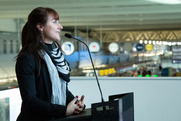
Area residents will have an opportunity to meet the artist who will create an iconic piece of art at Minneapolis-St. Paul International Airport (MSP) and share elements of their Minnesota experience with her.
Jen Lewin, known for her large scale, technology-driven interactive artwork was recently selected to create a major piece that will be located at the airport's Terminal 1.
Anyone who is interested in meeting Lewin will have that opportunity at three upcoming community meetings.
- Thursday, June 7, 6-8 p.m., at the Weisman Art Museum, William Shepherd Room, on the University of Minnesota's East Bank campus.
- Friday, June 8, 6-8 p.m., Weisman Art Museum, William Shepherd Room
- Saturday, June 9, 10 a.m.-12 p.m., Northrop Auditorium, Best Buy Theater, also on the University of Minnesota's East Bank campus.
Lewin will design the piece, which will be visible on both the airport’s baggage claim and ticketing levels. A new opening between the levels is being developed as part of a multi-year project to expand and modernize the front of the terminal.
“With Jen’s help, we have an opportunity to install an engaging artwork that will reflect the airport and the region, help transform the arrivals and departures lobbies and, over time, become an iconic symbol of MSP,” said Brian Ryks, CEO of the Metropolitan Airports Commission (MAC).
Lewin already has experience creating interactive pieces in Minnesota; she designed the sidewalk harp located near Target Field. People walking by that piece can make music by waving their hands under a series of LED lights.
You can learn more about Lewin’s artwork at this web page.
|
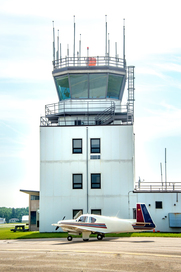
Summer events at the MAC’s reliever airports are starting to heat up. Whether you’re a fan of vintage aircraft, helicopter rides or simply a good pancake, you’ll find something to enjoy.
Three of the six reliever airports have public events next month. The fun starts on the weekend of June 2 and 3, when the Anoka County-Blaine Airport hosts its annual “Discover Aviation Days.” Rides on a B-25 are among the options.
On Father’s Day, June 17, both the Lake Elmo Airport and the Crystal Airport host events. The Minnesota Wing of the Civil Air Patrol holds a pancake breakfast at the Lake Elmo Airport, and Crystal’s open house and fly-in includes airplane and helicopter rides for a fee.
More information on each event is available at the links below.
Discover Aviation Days
Anoka County-Blaine Airport
Saturday and Sunday, June 2 and 3
7 a.m. to 4 p.m.
Details
CAP Father's Day Pancake Breakfast
Lake Elmo Airport
Sunday, June 17
8 a.m. to 12 p.m.
Details
Father's Day Open House
Crystal Airport
Sunday June 17
8 a.m. to 4 p.m.
Details
|
JetBlue recently kicked off service at Minneapolis–Saint Paul International Airport (MSP), with the airline’s inaugural flight from Boston Logan International Airport (BOS) touching down just before 9:00 a.m. on May 3.
The new flights in the Twin Cities mark the first-ever scheduled JetBlue service in Minnesota and bring a new option for travelers with the airline operating the route three times daily.
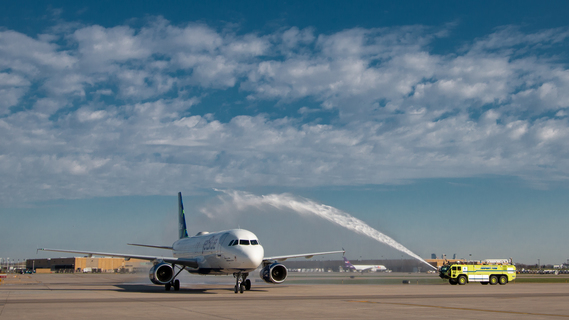
“The Metropolitan Airports Commission – together with our business partners in the community – has been pursuing service from JetBlue for a decade,” said Brian Ryks, CEO of the MAC. “JetBlue is one of the most respected airlines in the nation, and we couldn’t be more pleased to have this added service to Boston – the 10th most popular destination for Minnesota travelers.”
The new service is one of 48 new routes added at MSP by 11 airlines since 2016. There are currently 163 destinations served out of MSP.
The Metropolitan Airports Commission recently completed a crash exercise at Minneapolis-St. Paul International Airport, complete with almost 100 volunteers acting out roles and approximately 30 federal, state and local-level partners providing assistance.
On the evening of May 10, the volunteers helped the MAC conduct the drill based on a scenario in which a passenger airplane successfully lands at MSP but catches fire soon after due to an engine malfunction.
A video with scenes from the exercise is available here.
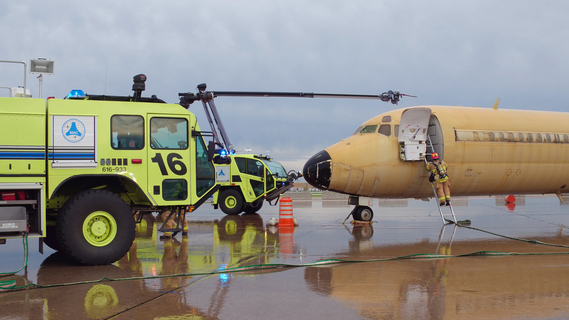
The mock emergency included airport fire crews and police officers responding to an aircraft in distress, first responders treating victims, airline managers deploying a multi-faceted response, airfield managers restricting flights and airport partners engaged in everything from transporting victims to assisting survivors and their families.
On the second day of the drill, May 11, MAC staff and many of its partners gathered at the MAC's administration building to work through a mock scenario that included reuniting family members and survivors, briefing the media and planning a return to normal airport operations.

Per Federal Aviation Administration rules, a crash exercise is performed every three years at MSP to ensure all parties are prepared to respond in the case of a real crisis.
Pictured: The Emergency Operations Center during the exercise.
For local Boy Scout James Hanley, this year's event presented a once-in-a-lifetime experience.
James had the unique opportunity to observe MSP's airport-wide emergency exercise to earn his emergency preparedness merit badge. As an aviation enthusiast, the unique behind-the-scenes experience exceeded his expectations.
"I was amazed by it all," said James. "I didn't realize everything it would involve."
To earn his emergency preparedness merit badge, James needed to contact a local emergency management director. Because of his interest in aviation, he selected the MAC's Manager of Emergency Programs, Kristi Rollwagen. And as luck would have it, he reached out to her just four days before the triannual exercise took place.
"His timing was unbelievable," Rollwagen said. "I knew this would be a great opportunity for him."
After getting his parents' permission to observe the exercise, Rollwagen worked to make sure he had opportunities to see every facet of the exercise. He even had the opportunity to ride along with Chief Mike Everson, Airport Police Department.
"That was awesome," said James of his ride along experience. "I basically got to go wherever I wanted."
Not only did James get to see the majority of the drill, he was also given an opportunity to provide feedback at the post-exercise "hot-wash" – a discussion of possible ways to improve the emergency response process. At the hot-wash, James suggested considering kids involved in incidents and ensuring they have activities to keep them occupied while in the survivors' center.
|
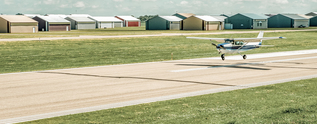
The MAC’s board recently approved a long-term comprehensive plan (LTCP) for the Airlake Airport, advancing a series of planned improvements at the airport.
Airlake, located in Lakeville, Minn. and Eureka Township, is adjacent to an industrial park just west of Cedar Avenue.
The improvements include:
- Extending both of the runway’s ends for a total length of 4,850 feet. The extension is about 750 feet total.
- Relocating 225th Street on the south side of the airport to accommodate runway changes.
-
Modifying some taxiway configurations.
- Runway 12's landing threshold at its northwest end would be shifted down the length of the runway 120 feet, toward the southeast, to provide aircraft a clear approach surface over train cars on an adjacent railroad track.
- Developing the south building area for additional hangars.
- Expanding the aircraft-parking apron.
The final LTCP report will serve as a basis for an environmental review of the improvements, which is expected to begin in 2019.
The environmental review will take 12-18 months to complete, during which time the MAC will engage with tenants, surrounding communities and agency partners. Once completed, the findings of the environmental review will be brought before the MAC’s board for discussion and approval.
|
(Editor’s note: Following is the fourth in a series of articles about how the Metropolitan Airports Commission came into being 75 years ago, and how the commission’s airport system has evolved over the decades.)
As the Twin Cities boomed in the 1950s, the Metropolitan Airports Commission found itself working to manage fast growth at Minneapolis-St. Paul International Airport.
Thousands of service men and women returned from duty overseas as World War II ended, and the 1950s saw tremendous growth in the Twin Cities area, with the population rising 26 percent during the decade to 1.9 million.
Northwest Airlines also saw its passenger numbers continuing to climb, aided by its strong market position on flights to Asia.

Teens on the observation deck on the former terminal on the east side of the airfield, 1954.
And Northwest wasn’t alone. Four scheduled airlines operated at MSP after WW II, and the original terminal building on the west side of the airfield became stretched beyond capacity by the mid-1950s.
The novelty of flight was still strong in 1950, the first year the airport’s observation deck was open on the west side of the airfield. The deck drew 264,000 visitors that year -- an average of more than 700 per day.
For the airlines, MSP had other draws. A Mississippi River flood in 1952 prompted Northwest Airlines to look for a new location for its maintenance base at the St. Paul Airport, which was susceptible to high water.
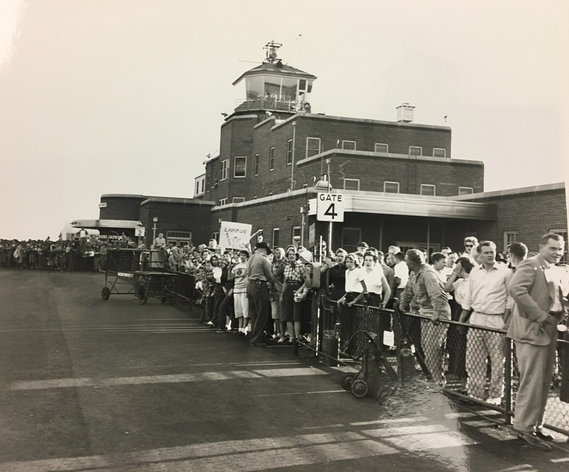
People awaiting a plane's arrival at the former MSP Terminal, 1950s.
In the mid-1950s construction started on a new Northwest Airlines overhaul maintenance base at MSP and the airline moved the St. Paul maintenance operations to the new facility in 1959. New general offices for Northwest and the maintenance base amounted to an $18 million investment and solidified MSP as the airline's home base.
In 1956, Northwest Airlines had 5,500 employees globally and was growing rapidly. Two years later, Northwest started modernizing its fleet, adding Lockheed Electras and Douglas DC-8s to the existing fleet of StratoCruisers.
By 1955 MSP had passed a milestone by serving more than 1 million passengers annually. That same year, 427 acres of Fort Snelling were deeded to the MAC, providing room for expansion of the airfield and needed facilities.
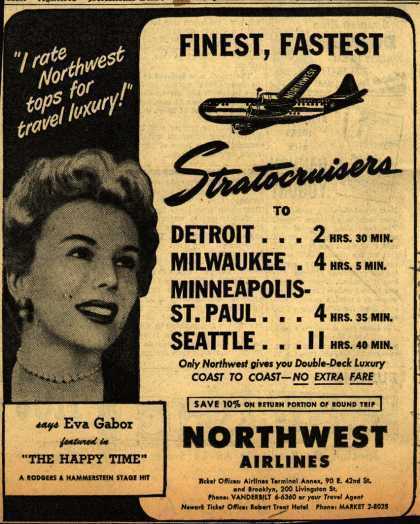
A Northwest Airlines ad featuring Eva Gabor, 1950.
Planning the new terminal
Studies of a new, modern facility began after forecasts projected that passenger counts would reach 4 million by 1975. The airlines supported the idea of a new terminal and the entire project was designed with future expansions in mind, including space for ticket counters, offices, waiting areas and more concessions.
The new terminal came with an $8.5 million price tag and was designed to handle 14,000 passengers per day.
Compared to other airports, the key design component that set the new terminal apart was putting passenger services on the top level, with baggage and ground transportation services on the lower level.

An organ was installed on a Northwest Stratocruiser in the 1950s through an arrangement with local musician Swanee Swanson. The organists received free flights to New York and other East Coast destinations.
Ground was broken in October 1958 on the east side of the airfield. The expansion plan, which totaled $47 million, also included a new control tower, access roads and upgrades to runways and taxiways.
Out front, the terminal had a new 2,500-space parking lot, also designed with room for expansion.
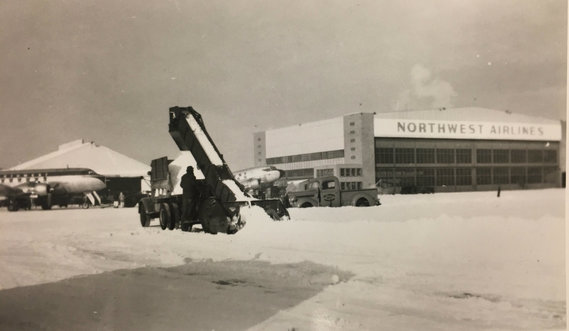
MSP airfield snow removal, 1950s-style.
Police and fire service grows along with the airport
The Airport Police Department started in 1947 when the MAC hired two officers to patrol the small terminal on the west side of the airfield and the adjacent parking lot.
The job description included turning off the lights each evening before they went home.

Pictured: A 1950s APD uniform patch.
The police department continued to add an officer or two each year during the 1950s, and then added 10 in 1962, the year the new terminal building opened. That brought the total to 25.
Police department milestones included the formation of a detective division in 1974 and a SWAT team in 1978.
For years, the police facilities were housed on the baggage claim level at Terminal 1. In 1984, police administration moved to the mezzanine level and the communications center moved to a shared space with Airside Operations.
Today, the Airport Police Department includes 115 sworn officers and 70 non-sworn personnel. They respond to a wide variety of calls as 38 million people pass through MSP annually.
|
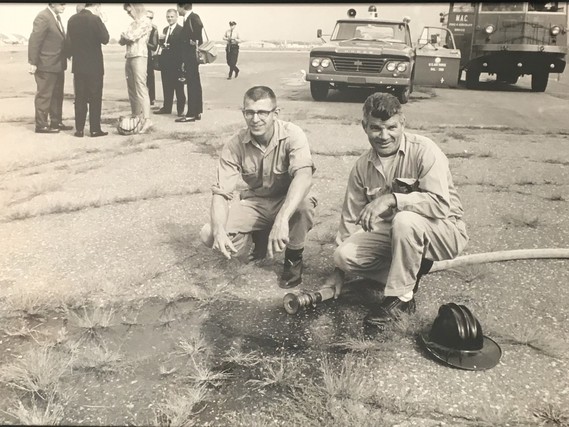
Airport Fire Department firefighters Howard Wanless (left) and Ed Muntean (right) pose on the MSP airfield on Aug. 21, 1965, awaiting the arrival of The Beatles, who performed at Met Stadium that day. Emergency crews were prepared for any crisis that might occur.
In its early days, MSP relied on the Minneapolis Fire Department for fire service. In the 1950s, Minneapolis had a fire station at the Naval Air Station and responded to calls from that location.
The Air Force eventually took over the firefighting responsibilities at the airport.
With the new terminal under construction in the late 1950s, the MAC moved toward launching its own fire department. In 1961 the Air Force Fire Department’s fire equipment was transferred to the MAC. In 1962, construction of a new fire station near the control tower began.
When runway 17/35 was planned, the airport needed a second fire station, due to an FAA rule that fire crews have to be able to reach the end of each runway within 3 minutes. The MAC built a new fire station next to Terminal 2 in 2005, and the Airport Fire Department administration also is based there.
Today, the Airport Fire Department has 51 employees, including administrative staff. About 70 percent of department calls are medical-related.
The new terminal gives MSP a modern look, room to expand
After more than three years of construction, the new terminal opened on Jan. 13, 1962. An open house the next day drew a crowd of 100,000. The Augsburg College Band and the Business and Industrial Choral Society provided the entertainment.
The exterior featured the eye-catching “sawtooth” roof with 17 folds, which is still a signature component of the building. The two concourses that extended off the terminal provided a total of 24 gates for aircraft.
The upper-level roadway in front of the terminal came with a state-of-the-art built-in snow-melting system. Services in the ticketing lobby initially included a drugstore and a children’s nursery.

The new terminal at its opening in 1962.
As with all US airports, there were no security checkpoints at MSP until the early 1970s.
Closer to the airport’s two concourses, passengers could find food services including a dining room, snack bar and coffee shop all served by a common kitchen.
Initially, the terminal’s two concourses were called Piers B and C. However, the names sounded too similar on the 1960s public address system used at MSP, and they were changed to Blue and Red – known today as Concourses E and F.

The interior of Terminal 1 when it opened.
The first flight to arrive at the terminal was operated by Northwest Airlines and arrived a week after the public opening, on Jan. 21.
The projected growth in passenger numbers in the mid-1950s lived up to expectations, as the airport served 756,000 passengers in 1950, booming to 1.8 million in 1960.
The number of carriers serving MSP had continued to expand as well. Eastern Air Lines and Ozark Airlines had entered the market in the late 1950s, and Western, United, North Central and Braniff were also offering flights at MSP.
The first scheduled jet aircraft flight came through the airport on Jan. 5, 1961, as a Northwest Airlines DC-8 stopped at MSP in route to Chicago. Braniff began jet service to MSP four months later.
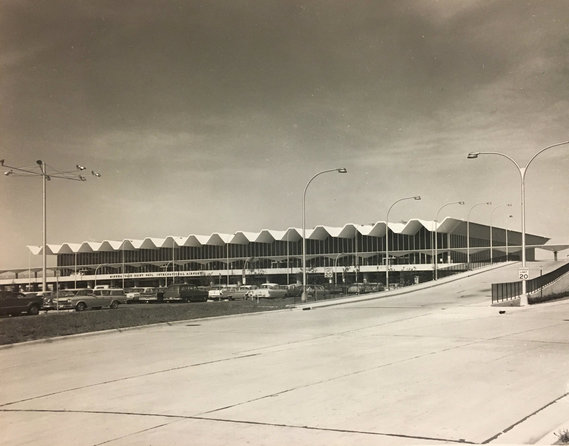
Surface parking available in front -- the new Lindbergh Terminal's exterior in the 1960s.
As the jet age arrived at MSP, neighborhoods around the airport were in the midst of the Baby Boom. As evidence, enrollment in the Richfield Public Schools went from 2,506 in 1950 to 10,055 in 1960.
With more people moving into newly built subdivisions near MSP, airport noise started to attract more attention. That noise, particularly from commercial jetliners, would play a key role in a late-1960s push to move the airport farther away from the urban center.
Sources of information for this article:
Minnesota Historical Society Archives.
Metropolitan Airports Commission archive materials.
MAC Police and Fire Departments.
"America's North Coast Gateway," by Karl Bremer.
Board Meetings
Business Opportunities
Career Opportunities
General Aviation Airport Information
MSP Aircraft Noise Information
MSP Airport
|